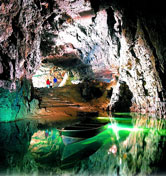
Indoor pool included
If you aren’t scared of enclosed spaces and you are looking for an off-grid hidey-hole in Northern England, you couldn’t do better than a cave. There are hundreds to choose from, all empty, and a new report lists them all with notes about what makes the most attractive living conditions.
With the coming summer expected to be the hottest for hundreds of years, even hotter than last year which was itself a record breaker, a nice cool cave might be just the thing. But hurry to nab your place before someone else does.
The new report, a special three-year study of more than 400 caves in the Peak District and Yorkshire Dales National Parks, jointly led by Bradford and Sheffield Universities academic, was released today (see https://capra.group.shef.ac.uk).
The project team recorded the setting and dimensions of each cave., so you will be able to work out if your furniture will fit in there, and looked to establish which criteria made particular caves attractive for use in the past. These findings will now guide national policies for cave conservation.
CONTINUES AFTER AD
 “Prehistoric Cavers Of Mammoth Cave” – buy it from Amazon
“Prehistoric Cavers Of Mammoth Cave” – buy it from Amazon
There were five main elements that made for a good cave back in the stone age, and perhaps unsurprisingly the most important was a good view from out of the cave mouth.
From 4,000 to 2,000 B.C. there was a higher frequency of usage of caves with larger entrances and deeper passages, also of caves that were higher in altitude and caves with entrances that faced towards the east or to the west,” said co-author Andrew Chamberlain of the University of Sheffield’s Department of Archaeology.
He added that most of the caves linked to human activities tended to have level areas outside of the entrances.
The archaeologists discovered that the Peak District attracted more prehistoric cave users than the Yorkshire Dales, suggesting that today’s “location, location, location” real estate mantra might have also been true 6,000 years ago.
“The (Peak District) region is a more productive area for agriculture today,” said Chamberlain, “and the same may have been true in prehistoric times and thus there may have been more people in the Peak District.”
He said it is also a possibility people there simply utilized caves more. Chamberlain explained that caves served a multitude of purposes aside from housing the ancients.
“Pre-historic hunters and farmers used them to stay in as they travelled through the landscape – almost like an ancient B & B – and they were also used as burial grounds and as storage facilities.
From the items found inside, the team concluded the Castleton area, the Manifold Valley in Staffordshire and Dovedale were the most popular places for cave dwellers, and this summer, off-grid confidently expects they will be again. .
Professor Chamberlain said: “We concluded the location was important to cave dwellers after looking at the setting of the caves.
“Entrances would face a certain way to account for the weather – the sun mostly shines from the south and the wind blows from the west.
“The size of the cave itself and size of the entrance were also important, for example the entrance would be smaller if the caves were to be used for secret activities.”